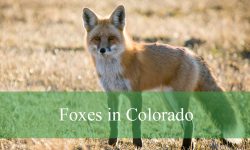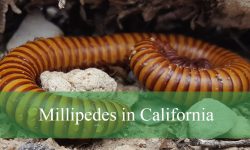Hawks in Nebraska can be seen soaring over grasslands, circling above open fields, or perching quietly along fence posts and tree branches. With their sharp eyesight and impressive hunting skills, these raptors play an important role in the state’s ecosystem. Nebraska’s mix of prairies, woodlands, and wetlands provides ideal habitats for a wide range of hawk species.
Some hawks in Nebraska are permanent residents, while others appear only during migration or winter months. Each species has its own unique behaviors, preferred habitats, and physical traits—from the powerful Red-tailed Hawk to the agile Sharp-shinned Hawk. Observing them closely reveals just how diverse and specialized these birds can be.
This article introduces 11 species of hawks in Nebraska, along with pictures and identification tips to help you recognize them. With a little patience and a good view of the sky or treetops, these impressive birds are easy to spot throughout the state.
Common Hawks in Nebraska
Red-tailed Hawk
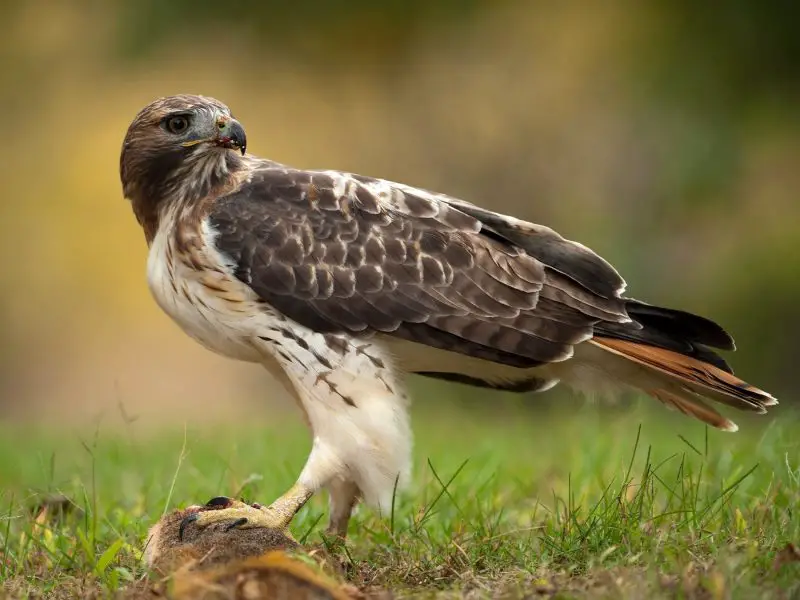
The Red-tailed Hawk (Buteo jamaicensis) is the most widespread and easily recognized hawk in Nebraska. Adults are large raptors with broad, rounded wings and a short, wide tail that is famously brick-red in color. Their upperparts are generally brown, while the underparts are pale with a dark belly band. Juveniles lack the red tail and have more streaked undersides. This species can reach lengths of 19 to 25 inches and has a wingspan between 4 to 5 feet.
This hawk is known for its raspy, descending scream—often used in movies as the default eagle sound. Red-tailed Hawks are skilled hunters, often seen perched along roadsides or soaring in wide circles over open fields. They rely on their excellent eyesight to spot prey from a distance and will dive swiftly to capture it. Their diet mainly includes small to medium mammals like rabbits, voles, and squirrels, but they may also eat birds, reptiles, and carrion.
In Nebraska, Red-tailed Hawks are year-round residents found across the entire state. They prefer open habitats such as grasslands, pastures, agricultural fields, and deserts but will also nest in wooded areas or even on urban structures like telephone poles. Nests are usually large platforms built high in trees or on cliff ledges.
A fun fact about the Red-tailed Hawk is that it often forms lifelong pairs. During courtship, pairs can be seen flying together in acrobatic displays, including high circling and talon-locking dives. Their adaptability has allowed them to thrive in both wild and human-altered environments.
Swainson’s Hawk

Swainson’s Hawk (Buteo swainsoni) is a long-winged, slim-bodied hawk with a pale underside and a characteristic dark bib on the chest. Adults typically show a light belly, brown back, and dark flight feathers contrasting with the white underwings. There are also dark morphs with nearly all-dark plumage. It is slightly smaller than the Red-tailed Hawk, with a wingspan of about 4 feet and a length of 18 to 22 inches.
This hawk is best known for its long-distance migration, traveling up to 14,000 miles round-trip between North America and Argentina each year. In Nebraska, Swainson’s Hawks are summer residents, arriving in late spring to breed and leaving by early fall. They hunt mostly from the air or elevated perches, often hovering before diving on prey. Unlike many raptors, Swainson’s Hawks consume large numbers of insects, especially grasshoppers and dragonflies, in addition to rodents and small birds.
Swainson’s Hawks are most commonly seen in Nebraska’s western and central grasslands, agricultural fields, and prairies. They nest in isolated trees, shelterbelts, or on utility poles in open country, usually where farming or ranching occurs. Their presence is a strong indicator of healthy prairie and open farmland ecosystems.
A fascinating fact about Swainson’s Hawks is their social nature during migration. They often gather in massive flocks, known as kettles, sometimes numbering in the thousands. These swirling groups use thermals to conserve energy while soaring southward in fall—an awe-inspiring spectacle for birders.
Ferruginous Hawk
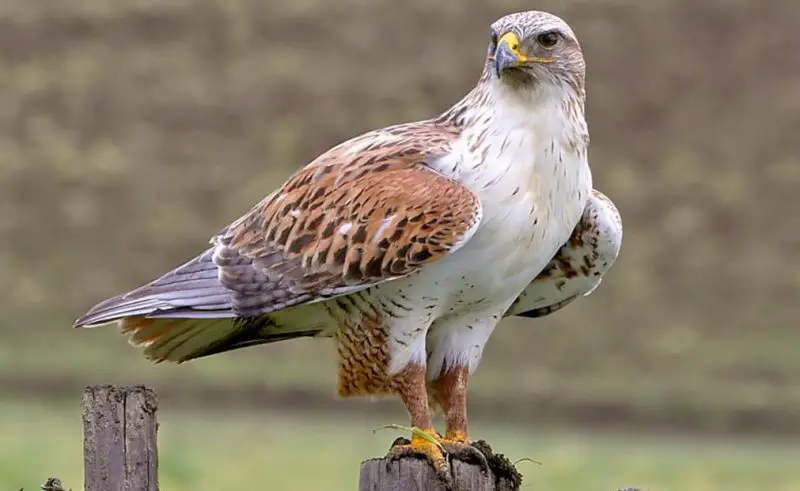
The Ferruginous Hawk (Buteo regalis) is the largest hawk species in North America, reaching lengths of 22 to 27 inches and wingspans of up to 56 inches. As its name implies, this raptor has rich, rusty-colored (ferruginous) feathers on its back and legs, with a pale head and underparts. It has long wings and a broad, flat tail. Unlike other buteos, its legs are feathered all the way to the toes.
Ferruginous Hawks are open-country specialists, rarely seen in wooded areas. They prefer hunting on the wing, often gliding low over the ground in search of prey. These hawks primarily feed on prairie dogs, ground squirrels, rabbits, and other small mammals, making them important predators in grassland ecosystems. They can be quite aggressive during nesting season and may even dive at humans who approach their territory.
In Nebraska, Ferruginous Hawks are rare but regular breeders in the western panhandle, particularly in shortgrass prairies, rangeland, and badlands. Their nests are typically large structures built on the ground, in shrubs, or on rock outcrops—sometimes even on hay bales or abandoned buildings. Habitat loss and human disturbance have made their populations vulnerable in some regions.
A unique trait of Ferruginous Hawks is their wing posture during flight. They often hold their wings in a shallow “V” shape while soaring, and their large size combined with pale coloration gives them an almost eagle-like silhouette. Their presence is considered a hallmark of undisturbed prairie.
Rough-legged Hawk
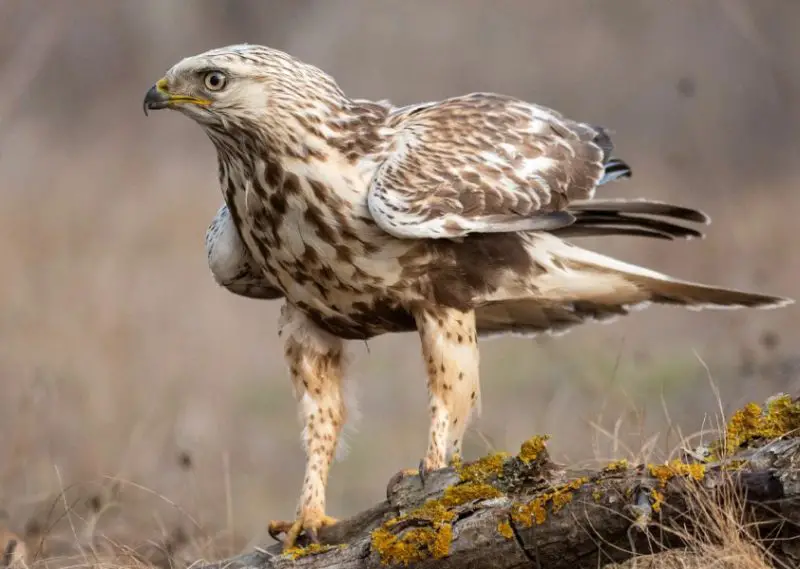
The Rough-legged Hawk (Buteo lagopus) is a winter visitor in Nebraska, migrating south from the Arctic tundra where it breeds. It is named for its feathered legs, which help insulate against extreme cold. This medium-to-large hawk is easily recognized by its dark belly, light head, and distinctive black patches at the wrists of its wings in flight. Both light and dark morphs exist, with the light morph being more common.
Rough-legged Hawks are graceful fliers and can hover in place while hunting, a behavior more common among kestrels than large hawks. They feed primarily on small mammals like voles, lemmings, and mice, often hunting in open fields and agricultural areas. Their flight is buoyant and fluttery, often gliding with wings raised in a shallow “V” similar to Ferruginous Hawks.
These hawks are found across Nebraska from late fall through early spring, especially in open areas like prairies, wetlands, pastures, and crop fields. They tend to avoid heavily wooded regions, preferring the wide, unobstructed landscapes where they can spot prey from afar. They often perch on fence posts or lone trees.
An interesting fact about the Rough-legged Hawk is that it’s one of the few raptors that builds its nest on the ground in the Arctic, usually on cliffs or rock ledges. Its long, feathered legs are a rare adaptation among hawks and are shared only with the Golden Eagle.
Red-shouldered Hawk
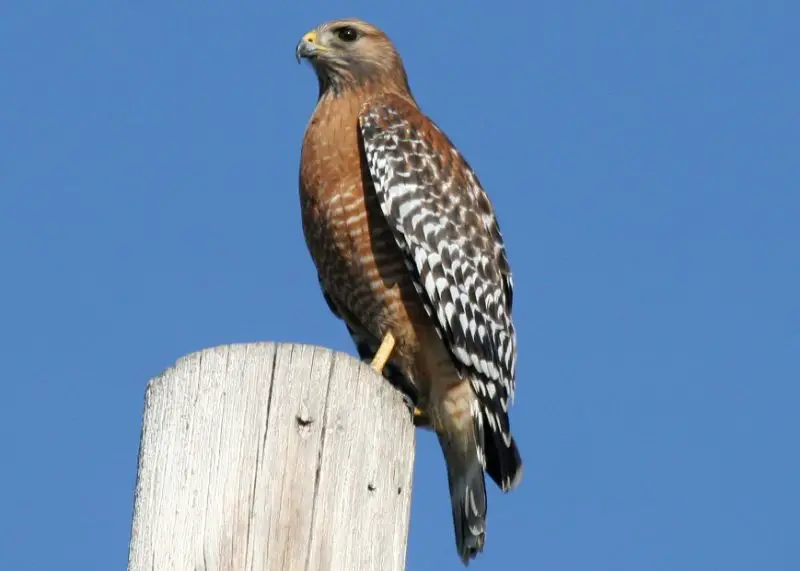
The Red-shouldered Hawk (Buteo lineatus) is a medium-sized forest hawk recognized by its striking reddish-brown shoulders, boldly barred underparts, and black-and-white checkered wings. Adults have a long tail with narrow white bands. They are smaller than Red-tailed Hawks, averaging 16 to 24 inches in length with a wingspan up to 42 inches.
This species is known for its loud, whistled “kee-aah” call, which it repeats in bursts while patrolling its territory. Red-shouldered Hawks are agile fliers within dense woodlands, where they hunt from low perches or glide silently through the trees. They feed on small mammals, amphibians, reptiles, and even crayfish, often hunting near water.
In Nebraska, Red-shouldered Hawks are uncommon but found mostly in the southeastern and eastern parts of the state, where large, mature forests remain. They favor deciduous woods near rivers, wetlands, and swamps. Their nests are typically high in the forks of tall trees and reused for several years.
A notable behavior of Red-shouldered Hawks is their tendency to share habitat with Barred Owls, sometimes nesting in the same woodland. They are also among the most vocal of North American hawks, and their piercing cries often reveal their location long before they are seen.
Broad-winged Hawk

The Broad-winged Hawk (Buteo platypterus) is a small, compact buteo with broad, rounded wings and a short tail with distinct black and white bands. Adults have a rich brown back and pale underparts with fine reddish barring. At 13 to 17 inches long and a wingspan of about 35 inches, it is among the smaller hawks in the state.
This hawk is best known for its spectacular fall migration, when thousands form swirling flocks called kettles as they travel to Central and South America. During breeding season, Broad-winged Hawks are quiet and secretive, nesting in large forests. They hunt from perches, diving quickly onto frogs, insects, small birds, and mammals.
In Nebraska, Broad-winged Hawks are uncommon summer residents mainly in the eastern and northeastern woodlands. They require large tracts of forest to nest and are often overlooked due to their preference for thick canopy. Migrating birds may be seen more widely during spring and fall.
A fun fact about the Broad-winged Hawk is that its migration route can span over 4,000 miles, and it makes the journey every year. Birdwatchers often gather at hawk watch sites during fall to witness these huge kettles circling on warm thermals—a truly memorable sight.
Sharp-shinned Hawk
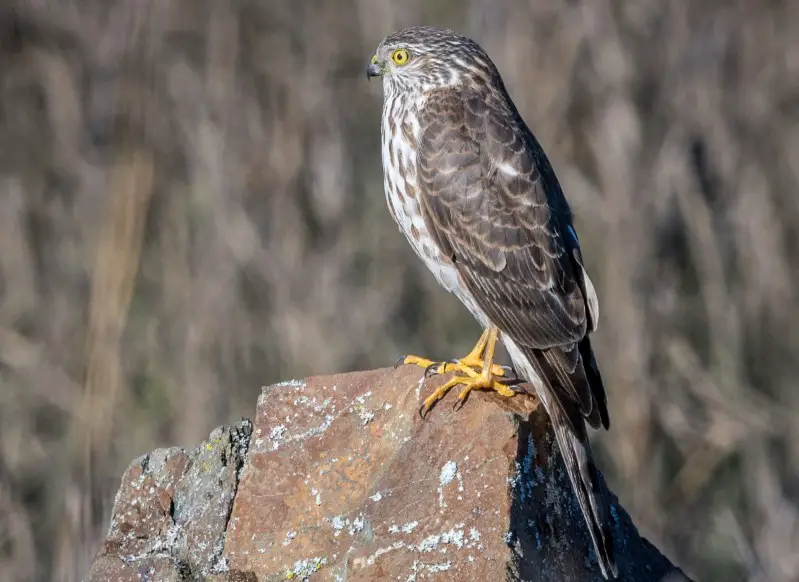
The Sharp-shinned Hawk (Accipiter striatus) is the smallest hawk species in North America, measuring 9 to 13 inches in length with a wingspan between 17 and 22 inches. Adults have a bluish-gray back, a dark crown, and orange-barring across the chest, while juveniles are brown above with streaky underparts. They have short, rounded wings and a long, square-tipped tail that helps them maneuver quickly through dense forest canopies.
This hawk is a secretive and agile predator, often darting through trees or ambushing prey near bird feeders. It primarily hunts small songbirds such as sparrows, finches, and warblers, but it may also eat small mammals and insects. It usually strikes with speed and surprise, grabbing prey mid-air or from the ground.
In Nebraska, the Sharp-shinned Hawk is mainly seen during migration in spring and fall, though some may stay through winter. They are more common in wooded areas and suburban neighborhoods where backyard bird activity attracts their attention. Unlike larger hawks, they avoid open fields and prefer areas with thick vegetation.
A fun fact about the Sharp-shinned Hawk is that females are about one-third larger than males—an unusual trait among birds but typical in raptors. This size difference allows pairs to target different types of prey, reducing competition between mates during nesting season.
Cooper’s Hawk
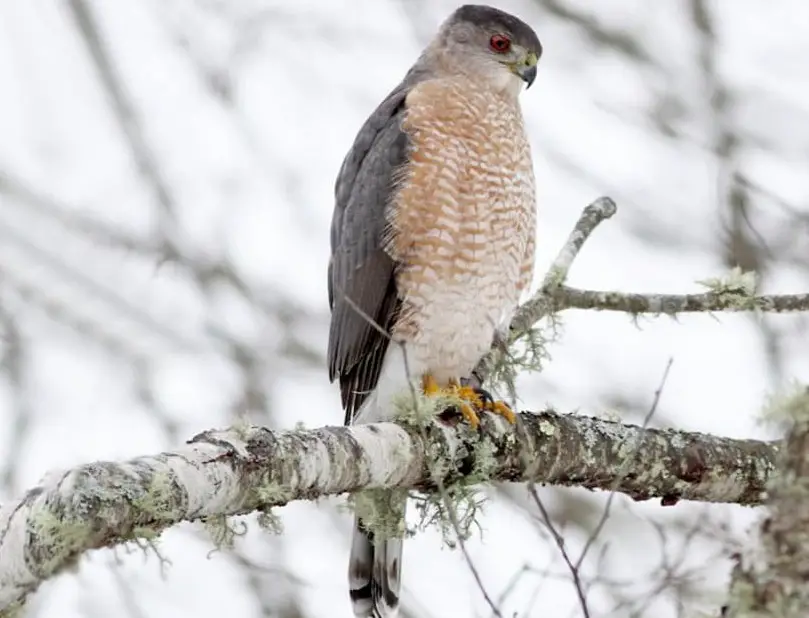
Cooper’s Hawk (Accipiter cooperii) is a medium-sized accipiter that is often confused with the Sharp-shinned Hawk due to similar features. However, Cooper’s Hawks are larger—14 to 20 inches in length—and have a rounded tail with a white tip, giving them a more “C-shaped” profile in flight. Adults have a slate-gray back, red eyes, and reddish barring across the breast, while juveniles are brown with streaked underparts.
These hawks are stealthy and aggressive hunters, specializing in capturing birds mid-flight. They are commonly found near feeders where they ambush songbirds, using swift and powerful strikes. Their long tails and short wings give them excellent control while flying through tight spaces.
In Nebraska, Cooper’s Hawks are widespread and increasingly common in both rural woodlands and urban areas. They breed throughout the state and can be found nesting in suburban neighborhoods, city parks, and forest edges. Their adaptability has made them one of the more successful urban raptors in recent decades.
A fascinating trait of Cooper’s Hawks is their acrobatic flight—these birds can twist, turn, and thread through trees at high speeds. They’re so maneuverable that they often fly into objects or suffer injuries while chasing prey. In fact, healed fractures are often found on the skeletons of adults.
Northern Goshawk

The Northern Goshawk (Accipiter atricapillus) is the largest of the accipiters, known for its powerful build and fierce demeanor. Adults have striking gray plumage with a dark head cap and piercing red eyes, and a distinctive white eyebrow stripe. Juveniles are brown with bold streaking below. They measure between 20 and 25 inches long and have a wingspan of up to 46 inches.
This hawk is a secretive predator of deep forests and is rarely seen in open areas. It hunts a wide variety of prey including birds, squirrels, hares, and other small to medium-sized mammals. It uses surprise attacks from perches or through silent flight, crashing through foliage with incredible agility.
In Nebraska, the Northern Goshawk is a rare and irregular winter visitor, primarily seen in the northern or western parts of the state. They favor coniferous or mixed forests and are most often spotted during irruptive years when food is scarce in their breeding range. Their elusive nature and preference for dense woods make them difficult to observe.
A notable fact about the Northern Goshawk is that it has been used historically in falconry for centuries, valued for its strength and bold temperament. In the wild, it defends its nest fiercely and will even dive at humans who get too close.
Northern Harrier
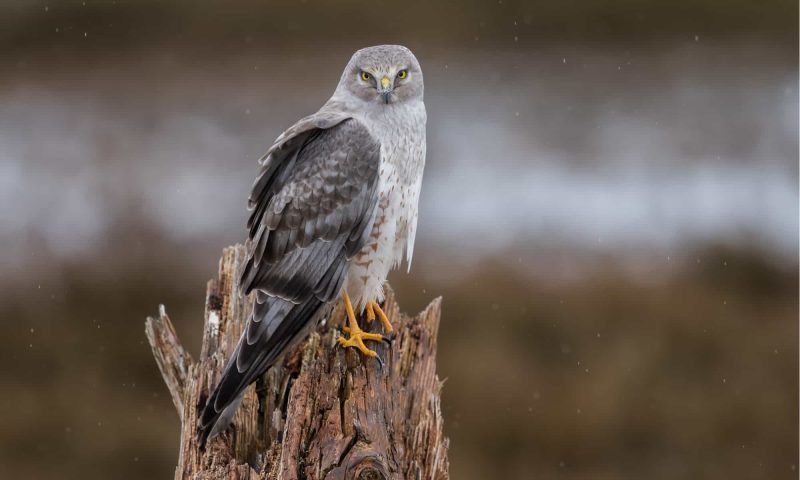
The Northern Harrier (Circus hudsonius), sometimes called the “Marsh Hawk,” is a long-winged, slender raptor with an owl-like facial disk. Males are gray with a white underside and black wingtips, while females and juveniles are brown with streaked bellies. All ages have a distinct white rump patch visible in flight. They measure 16 to 20 inches in length with a wingspan up to 48 inches.
This species is unique among hawks for its low, gliding flight pattern over open fields and marshes. Northern Harriers hunt by sound as well as sight, relying on their facial disk to detect the rustle of prey. They mainly eat voles, mice, frogs, and small birds, often diving suddenly after hovering above the ground.
Northern Harriers are widespread in Nebraska during migration and winter, but they also breed in parts of the state, especially in wet meadows, grasslands, and prairies. They build nests on the ground, hidden in tall vegetation, which makes them vulnerable to habitat destruction.
A fun fact about the Northern Harrier is that males may mate with multiple females during the breeding season—one of the few raptors known for this polygynous behavior. Despite their owl-like face, they are true hawks and belong to a separate genus from other buteos and accipiters.
Harris’s Hawk (Rare Visitor)
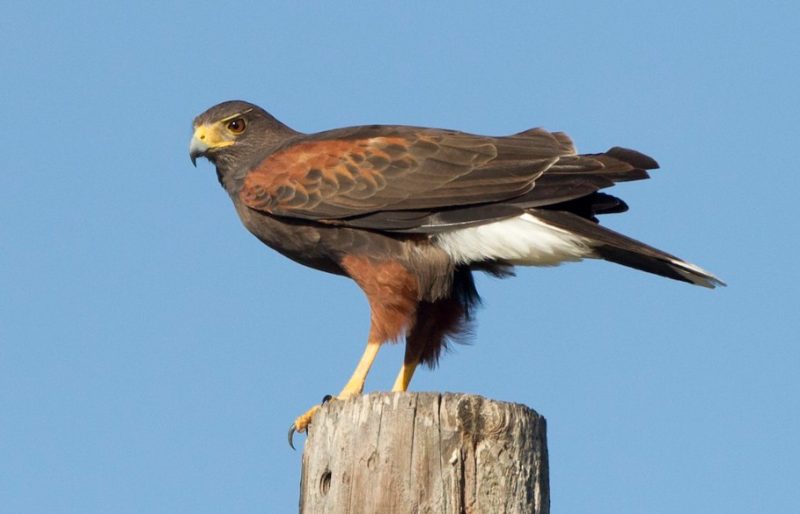
The Harris’s Hawk (Parabuteo unicinctus) is a striking, dark brown raptor with chestnut-red shoulders and thighs, and white markings on the rump and tail tip. It measures around 18 to 24 inches long and has a wingspan of 40 to 47 inches. Its long legs and upright posture give it a falcon-like silhouette.
Native to the arid southwest U.S., this species is extremely rare in Nebraska and considered an accidental visitor. Sightings typically involve escaped falconry birds rather than wild migrants. In its usual range, it inhabits deserts, scrublands, and open woodlands. It primarily feeds on rabbits, rodents, lizards, and birds.
One of the most remarkable behaviors of Harris’s Hawks is their cooperative hunting. Unlike most raptors, they hunt in family groups, taking turns flushing, chasing, and ambushing prey. This teamwork allows them to tackle larger or more elusive animals than they could alone.
A unique fact about Harris’s Hawks is that they are also called “wolves of the sky” because of their social hunting strategies. In falconry, they are popular due to their trainability, intelligence, and tolerance for working with humans.
Zone-tailed Hawk (Accidental Visitor)
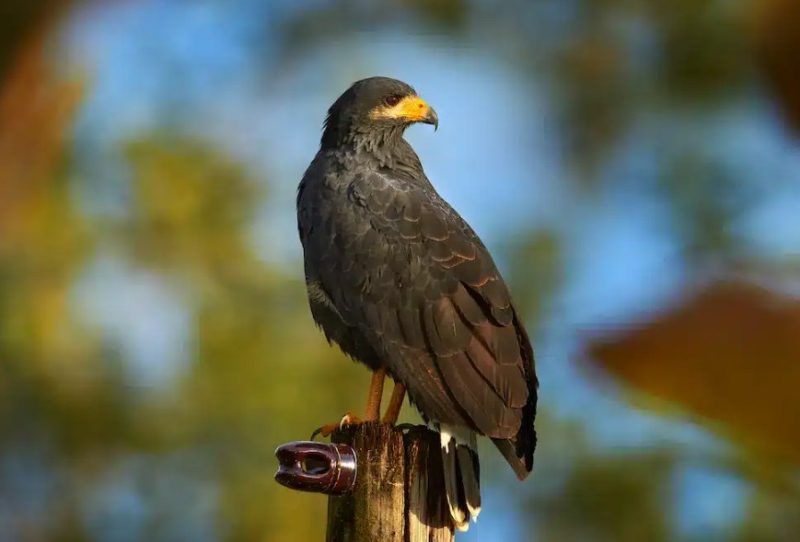
The Zone-tailed Hawk (Buteo albonotatus) closely resembles the more common Turkey Vulture in flight—black body, long wings held in a dihedral, and slow, gliding motion. However, it can be identified by its bold black-and-white tail bands and yellow legs and cere. Adults are uniformly dark with faint barring, and they measure about 18 to 22 inches long with a wingspan of around 48 inches.
This hawk is rarely recorded in Nebraska and is considered an accidental visitor, more commonly found in the southwestern United States and parts of Mexico. It prefers rocky canyons, desert foothills, and scrubby woodlands. Its diet includes lizards, birds, and small mammals, and it often uses the element of surprise while gliding low like a vulture to fool potential prey.
Zone-tailed Hawks nest in trees or cliffs, usually near water, and can be quite secretive. Because of their vulture-like flight and dark coloration, they are often overlooked or misidentified, which may lead to underreporting in areas outside their core range.
A fun fact about the Zone-tailed Hawk is that its resemblance to Turkey Vultures is thought to be a form of mimicry. By flying among vultures, which are non-threatening scavengers, it may get closer to prey animals without alarming them—an ingenious strategy for hunting.
Best Places to See Hawks in Nebraska
Nebraska offers a variety of excellent locations for observing hawks in their natural habitats. One of the most popular spots is the Platte River Valley, especially during spring and fall migrations. The wide-open skies and abundance of small prey make this area a prime hunting ground for Red-tailed Hawks, Swainson’s Hawks, and Northern Harriers. Look for them soaring above agricultural fields or perched on utility poles along rural roads.
Another great location is Lake McConaughy and the surrounding Sandhills region in western Nebraska. This vast landscape of grasslands, dunes, and wetlands attracts species like Ferruginous Hawks and Rough-legged Hawks in the winter months. The area’s remoteness provides a quiet refuge for raptors, and the open terrain makes them easier to spot from a distance. Keep binoculars handy, as many hawks can be seen gliding low in search of rodents.
In eastern Nebraska, Fontenelle Forest near Bellevue is an excellent place to see woodland hawks such as Cooper’s Hawk and Sharp-shinned Hawk. The dense canopy and nearby Missouri River create a perfect environment for these agile hunters. The forest has walking trails and viewing platforms where birdwatchers can quietly observe hawks as they fly through the trees or call from hidden perches.

